Analysing Organisational Performance Measurement and its Importance
VerifiedAdded on 2023/04/21
|9
|1936
|353
Essay
AI Summary
This essay discusses the significance of organisational performance measurement as a fundamental component of total quality management. It highlights the importance of performance management in tracking progress, identifying opportunities, and comparing internal and external standards. The essay also delves into the goal setting theory, where employees set personal goals to improve performance, and the expectancy theory, which links employee behavior to the attainment of organisational goals and rewards. Ultimately, the essay concludes that regular performance measurement fosters an environment where employees deliver optimal performance, contributing to the overall success of the company. Desklib provides access to similar solved assignments and study tools for students.
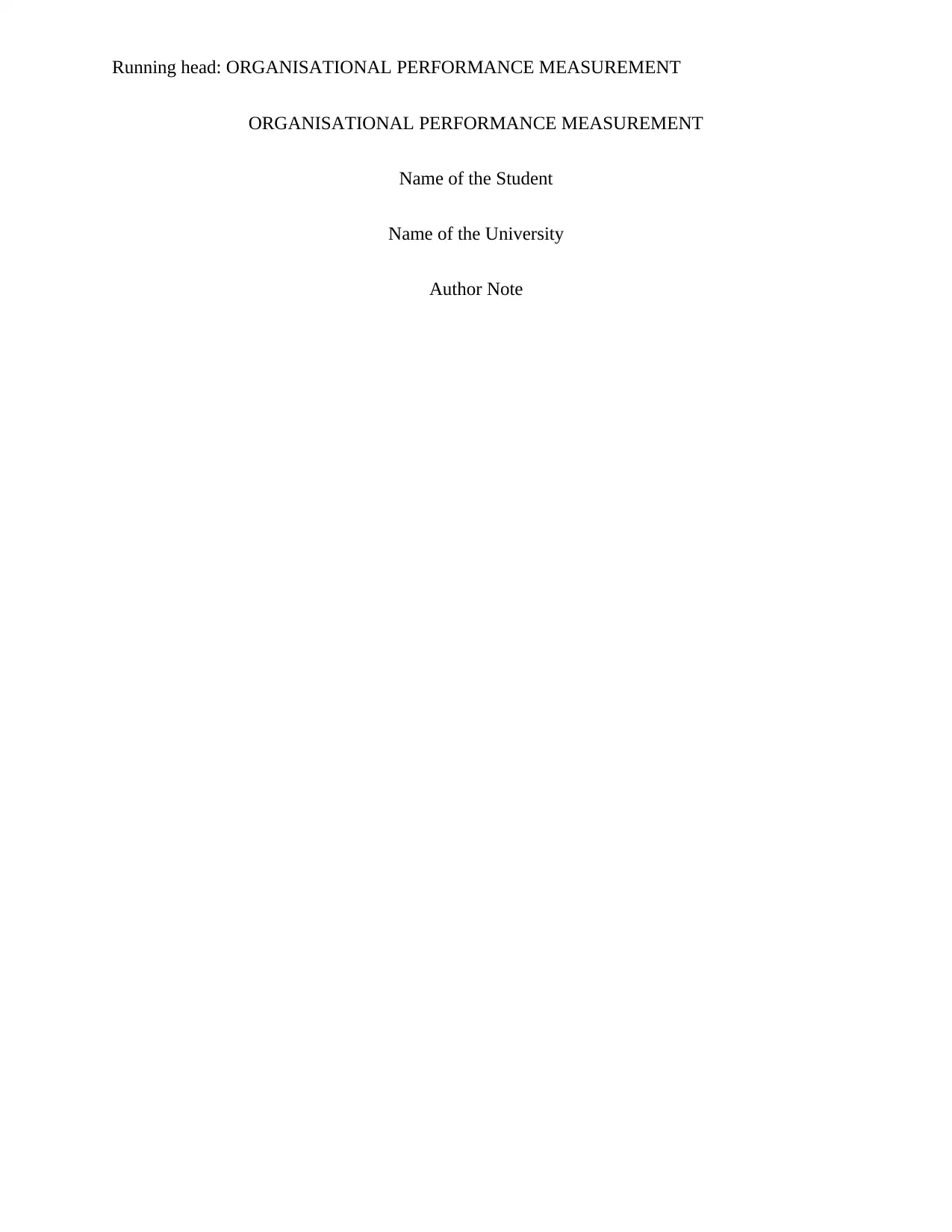
Running head: ORGANISATIONAL PERFORMANCE MEASUREMENT
ORGANISATIONAL PERFORMANCE MEASUREMENT
Name of the Student
Name of the University
Author Note
ORGANISATIONAL PERFORMANCE MEASUREMENT
Name of the Student
Name of the University
Author Note
Paraphrase This Document
Need a fresh take? Get an instant paraphrase of this document with our AI Paraphraser
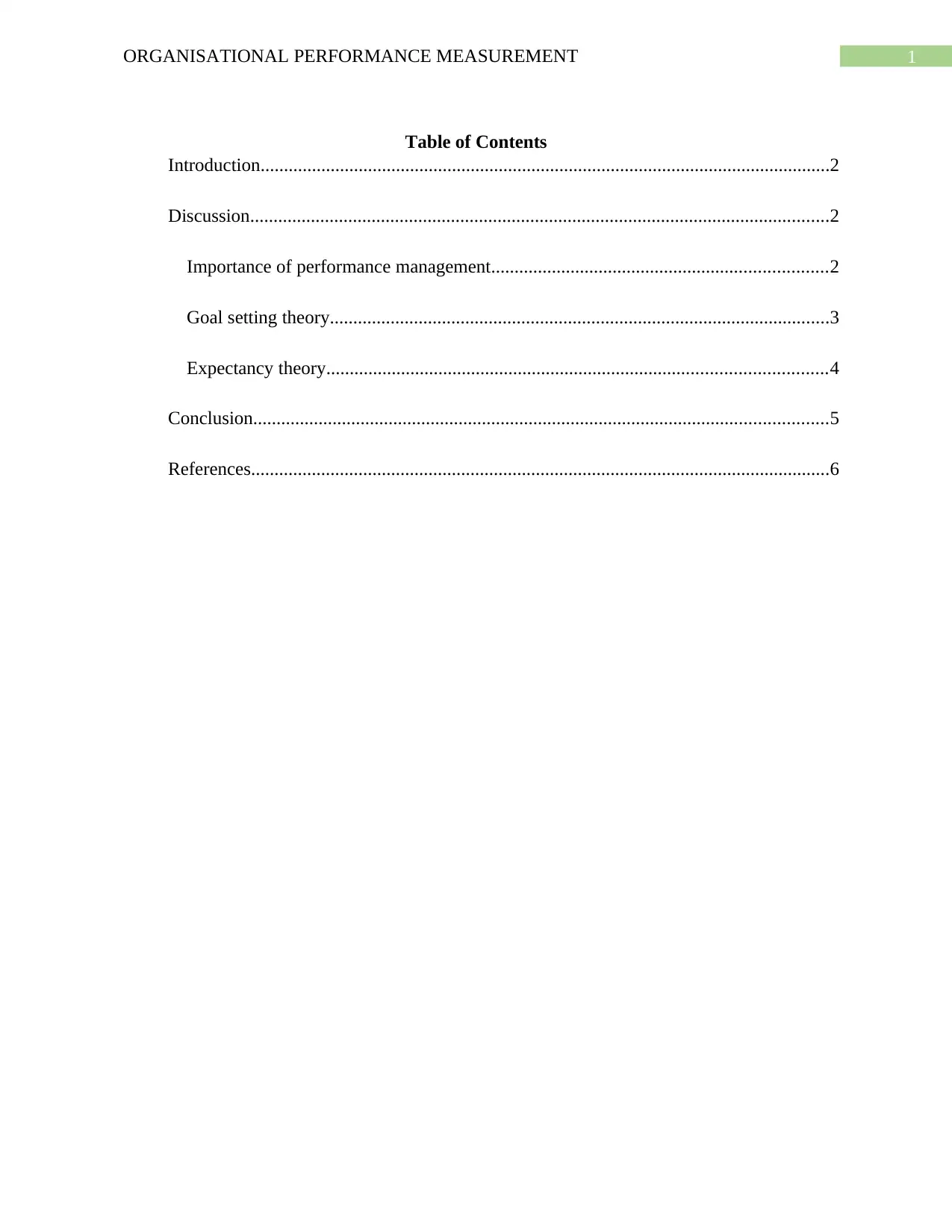
1ORGANISATIONAL PERFORMANCE MEASUREMENT
Table of Contents
Introduction..........................................................................................................................2
Discussion............................................................................................................................2
Importance of performance management........................................................................2
Goal setting theory...........................................................................................................3
Expectancy theory...........................................................................................................4
Conclusion...........................................................................................................................5
References............................................................................................................................6
Table of Contents
Introduction..........................................................................................................................2
Discussion............................................................................................................................2
Importance of performance management........................................................................2
Goal setting theory...........................................................................................................3
Expectancy theory...........................................................................................................4
Conclusion...........................................................................................................................5
References............................................................................................................................6
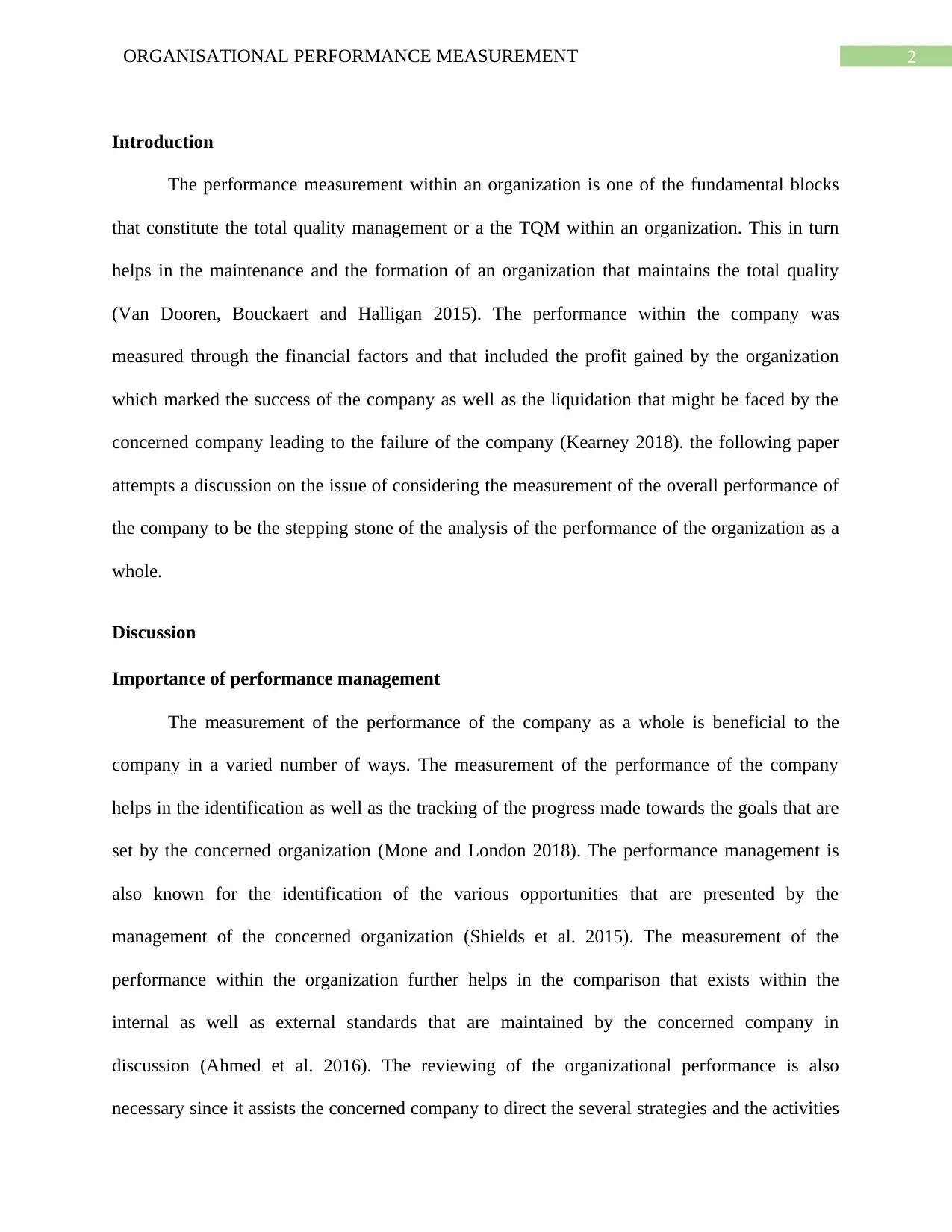
2ORGANISATIONAL PERFORMANCE MEASUREMENT
Introduction
The performance measurement within an organization is one of the fundamental blocks
that constitute the total quality management or a the TQM within an organization. This in turn
helps in the maintenance and the formation of an organization that maintains the total quality
(Van Dooren, Bouckaert and Halligan 2015). The performance within the company was
measured through the financial factors and that included the profit gained by the organization
which marked the success of the company as well as the liquidation that might be faced by the
concerned company leading to the failure of the company (Kearney 2018). the following paper
attempts a discussion on the issue of considering the measurement of the overall performance of
the company to be the stepping stone of the analysis of the performance of the organization as a
whole.
Discussion
Importance of performance management
The measurement of the performance of the company as a whole is beneficial to the
company in a varied number of ways. The measurement of the performance of the company
helps in the identification as well as the tracking of the progress made towards the goals that are
set by the concerned organization (Mone and London 2018). The performance management is
also known for the identification of the various opportunities that are presented by the
management of the concerned organization (Shields et al. 2015). The measurement of the
performance within the organization further helps in the comparison that exists within the
internal as well as external standards that are maintained by the concerned company in
discussion (Ahmed et al. 2016). The reviewing of the organizational performance is also
necessary since it assists the concerned company to direct the several strategies and the activities
Introduction
The performance measurement within an organization is one of the fundamental blocks
that constitute the total quality management or a the TQM within an organization. This in turn
helps in the maintenance and the formation of an organization that maintains the total quality
(Van Dooren, Bouckaert and Halligan 2015). The performance within the company was
measured through the financial factors and that included the profit gained by the organization
which marked the success of the company as well as the liquidation that might be faced by the
concerned company leading to the failure of the company (Kearney 2018). the following paper
attempts a discussion on the issue of considering the measurement of the overall performance of
the company to be the stepping stone of the analysis of the performance of the organization as a
whole.
Discussion
Importance of performance management
The measurement of the performance of the company as a whole is beneficial to the
company in a varied number of ways. The measurement of the performance of the company
helps in the identification as well as the tracking of the progress made towards the goals that are
set by the concerned organization (Mone and London 2018). The performance management is
also known for the identification of the various opportunities that are presented by the
management of the concerned organization (Shields et al. 2015). The measurement of the
performance within the organization further helps in the comparison that exists within the
internal as well as external standards that are maintained by the concerned company in
discussion (Ahmed et al. 2016). The reviewing of the organizational performance is also
necessary since it assists the concerned company to direct the several strategies and the activities
⊘ This is a preview!⊘
Do you want full access?
Subscribe today to unlock all pages.

Trusted by 1+ million students worldwide
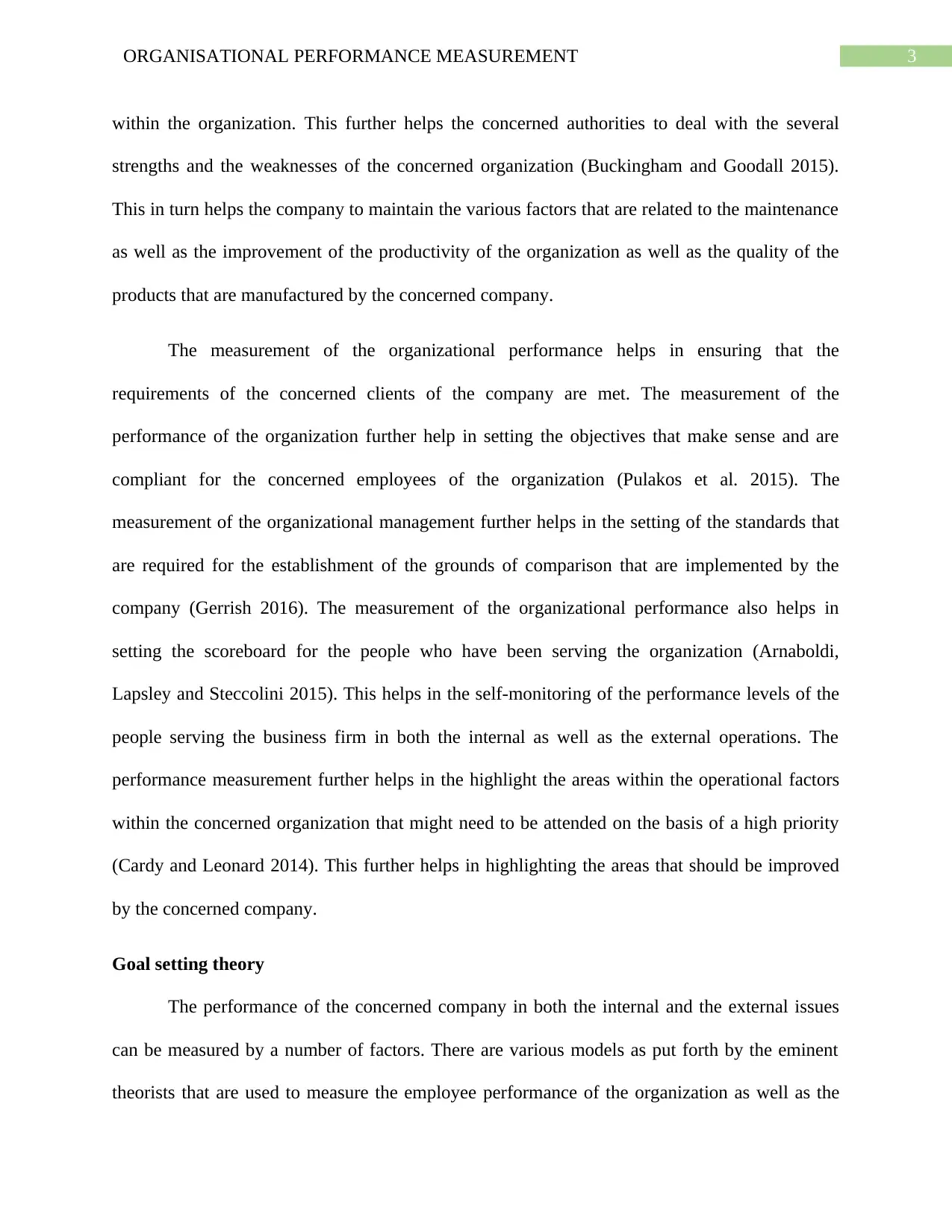
3ORGANISATIONAL PERFORMANCE MEASUREMENT
within the organization. This further helps the concerned authorities to deal with the several
strengths and the weaknesses of the concerned organization (Buckingham and Goodall 2015).
This in turn helps the company to maintain the various factors that are related to the maintenance
as well as the improvement of the productivity of the organization as well as the quality of the
products that are manufactured by the concerned company.
The measurement of the organizational performance helps in ensuring that the
requirements of the concerned clients of the company are met. The measurement of the
performance of the organization further help in setting the objectives that make sense and are
compliant for the concerned employees of the organization (Pulakos et al. 2015). The
measurement of the organizational management further helps in the setting of the standards that
are required for the establishment of the grounds of comparison that are implemented by the
company (Gerrish 2016). The measurement of the organizational performance also helps in
setting the scoreboard for the people who have been serving the organization (Arnaboldi,
Lapsley and Steccolini 2015). This helps in the self-monitoring of the performance levels of the
people serving the business firm in both the internal as well as the external operations. The
performance measurement further helps in the highlight the areas within the operational factors
within the concerned organization that might need to be attended on the basis of a high priority
(Cardy and Leonard 2014). This further helps in highlighting the areas that should be improved
by the concerned company.
Goal setting theory
The performance of the concerned company in both the internal and the external issues
can be measured by a number of factors. There are various models as put forth by the eminent
theorists that are used to measure the employee performance of the organization as well as the
within the organization. This further helps the concerned authorities to deal with the several
strengths and the weaknesses of the concerned organization (Buckingham and Goodall 2015).
This in turn helps the company to maintain the various factors that are related to the maintenance
as well as the improvement of the productivity of the organization as well as the quality of the
products that are manufactured by the concerned company.
The measurement of the organizational performance helps in ensuring that the
requirements of the concerned clients of the company are met. The measurement of the
performance of the organization further help in setting the objectives that make sense and are
compliant for the concerned employees of the organization (Pulakos et al. 2015). The
measurement of the organizational management further helps in the setting of the standards that
are required for the establishment of the grounds of comparison that are implemented by the
company (Gerrish 2016). The measurement of the organizational performance also helps in
setting the scoreboard for the people who have been serving the organization (Arnaboldi,
Lapsley and Steccolini 2015). This helps in the self-monitoring of the performance levels of the
people serving the business firm in both the internal as well as the external operations. The
performance measurement further helps in the highlight the areas within the operational factors
within the concerned organization that might need to be attended on the basis of a high priority
(Cardy and Leonard 2014). This further helps in highlighting the areas that should be improved
by the concerned company.
Goal setting theory
The performance of the concerned company in both the internal and the external issues
can be measured by a number of factors. There are various models as put forth by the eminent
theorists that are used to measure the employee performance of the organization as well as the
Paraphrase This Document
Need a fresh take? Get an instant paraphrase of this document with our AI Paraphraser
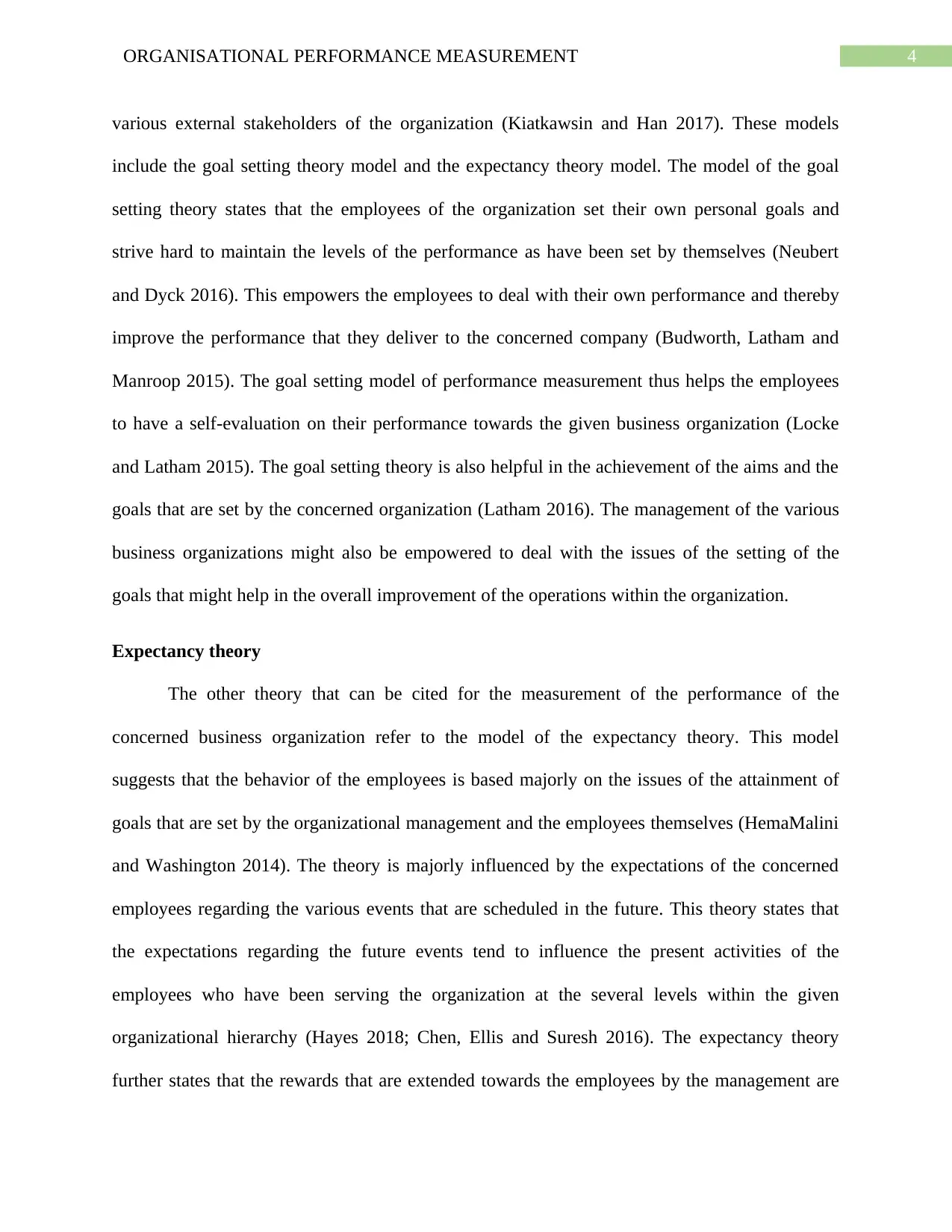
4ORGANISATIONAL PERFORMANCE MEASUREMENT
various external stakeholders of the organization (Kiatkawsin and Han 2017). These models
include the goal setting theory model and the expectancy theory model. The model of the goal
setting theory states that the employees of the organization set their own personal goals and
strive hard to maintain the levels of the performance as have been set by themselves (Neubert
and Dyck 2016). This empowers the employees to deal with their own performance and thereby
improve the performance that they deliver to the concerned company (Budworth, Latham and
Manroop 2015). The goal setting model of performance measurement thus helps the employees
to have a self-evaluation on their performance towards the given business organization (Locke
and Latham 2015). The goal setting theory is also helpful in the achievement of the aims and the
goals that are set by the concerned organization (Latham 2016). The management of the various
business organizations might also be empowered to deal with the issues of the setting of the
goals that might help in the overall improvement of the operations within the organization.
Expectancy theory
The other theory that can be cited for the measurement of the performance of the
concerned business organization refer to the model of the expectancy theory. This model
suggests that the behavior of the employees is based majorly on the issues of the attainment of
goals that are set by the organizational management and the employees themselves (HemaMalini
and Washington 2014). The theory is majorly influenced by the expectations of the concerned
employees regarding the various events that are scheduled in the future. This theory states that
the expectations regarding the future events tend to influence the present activities of the
employees who have been serving the organization at the several levels within the given
organizational hierarchy (Hayes 2018; Chen, Ellis and Suresh 2016). The expectancy theory
further states that the rewards that are extended towards the employees by the management are
various external stakeholders of the organization (Kiatkawsin and Han 2017). These models
include the goal setting theory model and the expectancy theory model. The model of the goal
setting theory states that the employees of the organization set their own personal goals and
strive hard to maintain the levels of the performance as have been set by themselves (Neubert
and Dyck 2016). This empowers the employees to deal with their own performance and thereby
improve the performance that they deliver to the concerned company (Budworth, Latham and
Manroop 2015). The goal setting model of performance measurement thus helps the employees
to have a self-evaluation on their performance towards the given business organization (Locke
and Latham 2015). The goal setting theory is also helpful in the achievement of the aims and the
goals that are set by the concerned organization (Latham 2016). The management of the various
business organizations might also be empowered to deal with the issues of the setting of the
goals that might help in the overall improvement of the operations within the organization.
Expectancy theory
The other theory that can be cited for the measurement of the performance of the
concerned business organization refer to the model of the expectancy theory. This model
suggests that the behavior of the employees is based majorly on the issues of the attainment of
goals that are set by the organizational management and the employees themselves (HemaMalini
and Washington 2014). The theory is majorly influenced by the expectations of the concerned
employees regarding the various events that are scheduled in the future. This theory states that
the expectations regarding the future events tend to influence the present activities of the
employees who have been serving the organization at the several levels within the given
organizational hierarchy (Hayes 2018; Chen, Ellis and Suresh 2016). The expectancy theory
further states that the rewards that are extended towards the employees by the management are
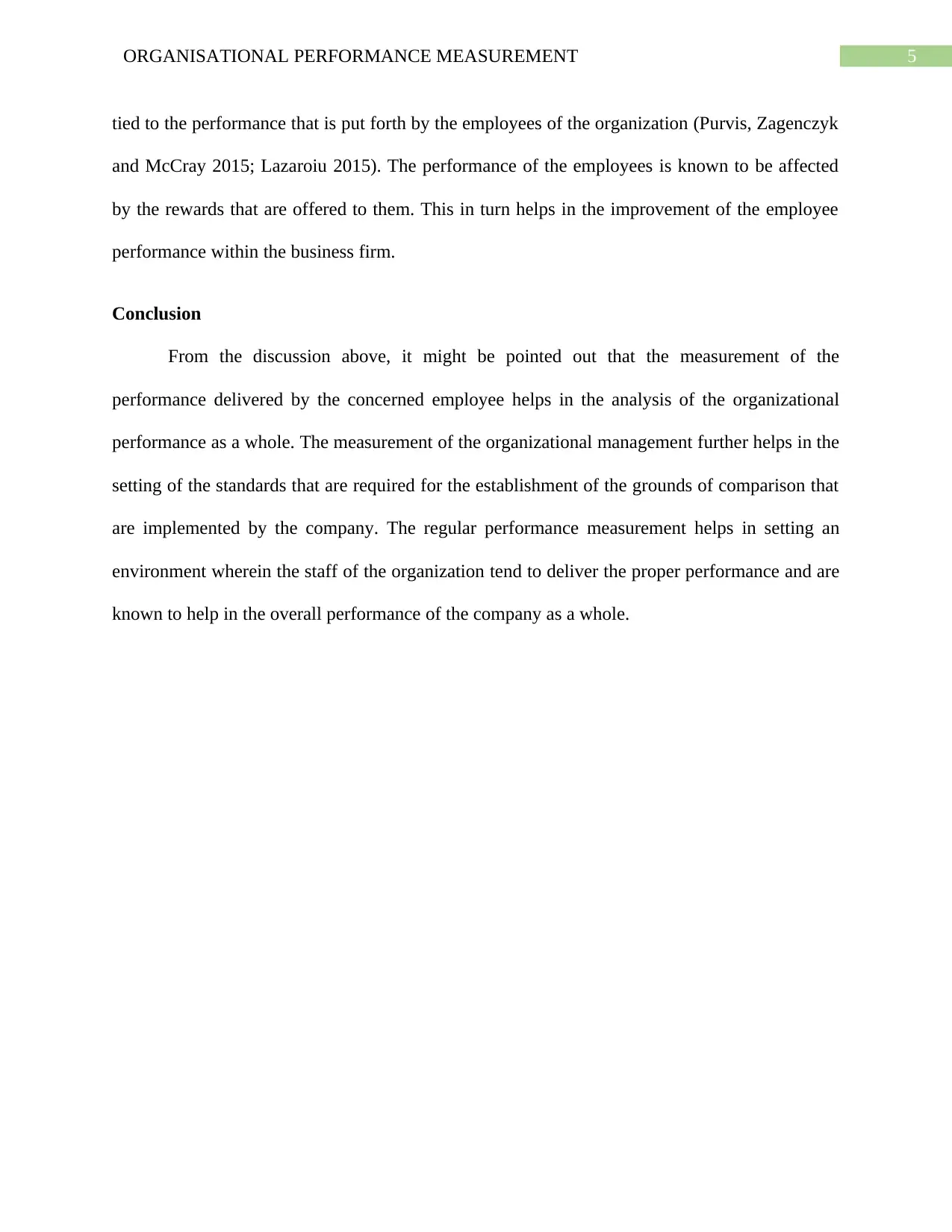
5ORGANISATIONAL PERFORMANCE MEASUREMENT
tied to the performance that is put forth by the employees of the organization (Purvis, Zagenczyk
and McCray 2015; Lazaroiu 2015). The performance of the employees is known to be affected
by the rewards that are offered to them. This in turn helps in the improvement of the employee
performance within the business firm.
Conclusion
From the discussion above, it might be pointed out that the measurement of the
performance delivered by the concerned employee helps in the analysis of the organizational
performance as a whole. The measurement of the organizational management further helps in the
setting of the standards that are required for the establishment of the grounds of comparison that
are implemented by the company. The regular performance measurement helps in setting an
environment wherein the staff of the organization tend to deliver the proper performance and are
known to help in the overall performance of the company as a whole.
tied to the performance that is put forth by the employees of the organization (Purvis, Zagenczyk
and McCray 2015; Lazaroiu 2015). The performance of the employees is known to be affected
by the rewards that are offered to them. This in turn helps in the improvement of the employee
performance within the business firm.
Conclusion
From the discussion above, it might be pointed out that the measurement of the
performance delivered by the concerned employee helps in the analysis of the organizational
performance as a whole. The measurement of the organizational management further helps in the
setting of the standards that are required for the establishment of the grounds of comparison that
are implemented by the company. The regular performance measurement helps in setting an
environment wherein the staff of the organization tend to deliver the proper performance and are
known to help in the overall performance of the company as a whole.
⊘ This is a preview!⊘
Do you want full access?
Subscribe today to unlock all pages.

Trusted by 1+ million students worldwide
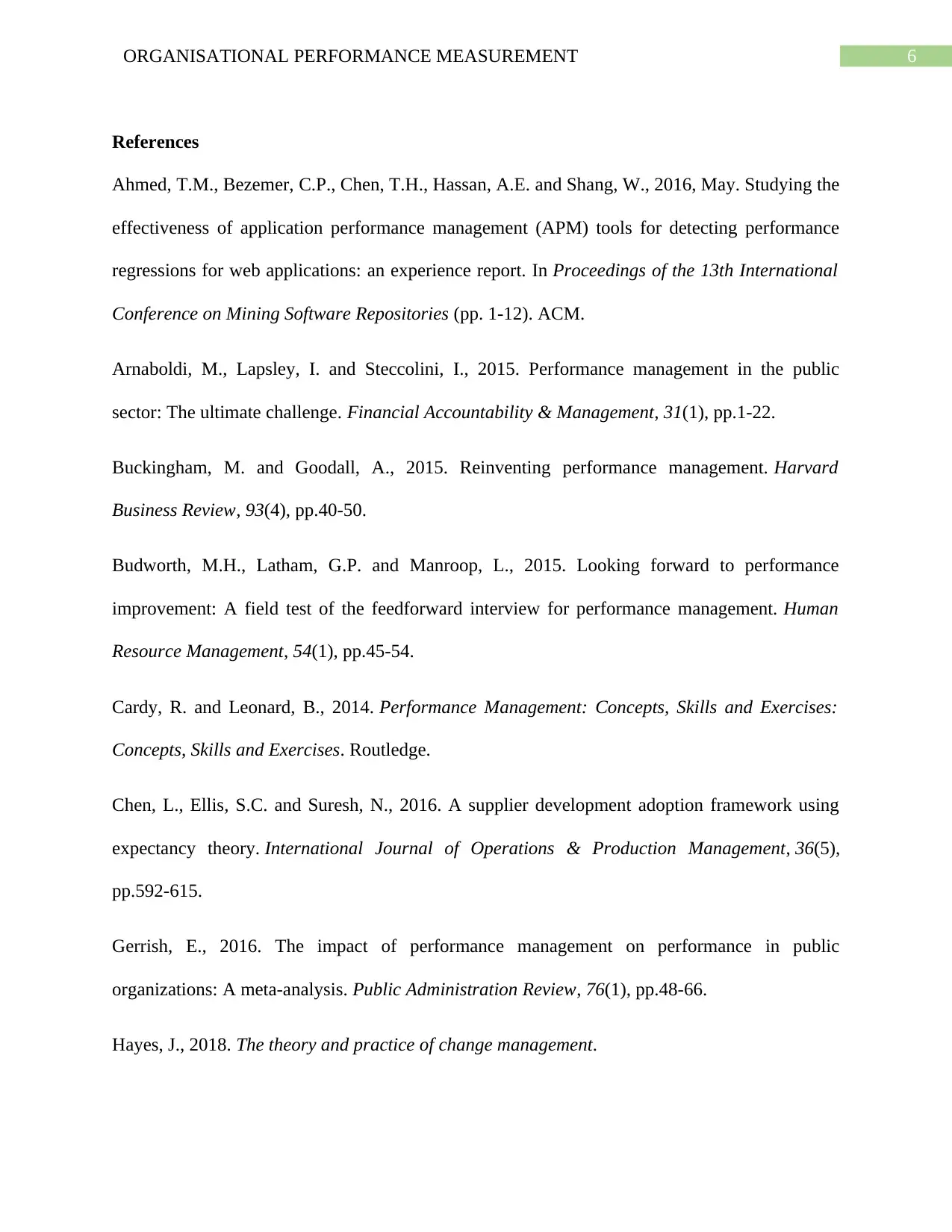
6ORGANISATIONAL PERFORMANCE MEASUREMENT
References
Ahmed, T.M., Bezemer, C.P., Chen, T.H., Hassan, A.E. and Shang, W., 2016, May. Studying the
effectiveness of application performance management (APM) tools for detecting performance
regressions for web applications: an experience report. In Proceedings of the 13th International
Conference on Mining Software Repositories (pp. 1-12). ACM.
Arnaboldi, M., Lapsley, I. and Steccolini, I., 2015. Performance management in the public
sector: The ultimate challenge. Financial Accountability & Management, 31(1), pp.1-22.
Buckingham, M. and Goodall, A., 2015. Reinventing performance management. Harvard
Business Review, 93(4), pp.40-50.
Budworth, M.H., Latham, G.P. and Manroop, L., 2015. Looking forward to performance
improvement: A field test of the feedforward interview for performance management. Human
Resource Management, 54(1), pp.45-54.
Cardy, R. and Leonard, B., 2014. Performance Management: Concepts, Skills and Exercises:
Concepts, Skills and Exercises. Routledge.
Chen, L., Ellis, S.C. and Suresh, N., 2016. A supplier development adoption framework using
expectancy theory. International Journal of Operations & Production Management, 36(5),
pp.592-615.
Gerrish, E., 2016. The impact of performance management on performance in public
organizations: A meta‐analysis. Public Administration Review, 76(1), pp.48-66.
Hayes, J., 2018. The theory and practice of change management.
References
Ahmed, T.M., Bezemer, C.P., Chen, T.H., Hassan, A.E. and Shang, W., 2016, May. Studying the
effectiveness of application performance management (APM) tools for detecting performance
regressions for web applications: an experience report. In Proceedings of the 13th International
Conference on Mining Software Repositories (pp. 1-12). ACM.
Arnaboldi, M., Lapsley, I. and Steccolini, I., 2015. Performance management in the public
sector: The ultimate challenge. Financial Accountability & Management, 31(1), pp.1-22.
Buckingham, M. and Goodall, A., 2015. Reinventing performance management. Harvard
Business Review, 93(4), pp.40-50.
Budworth, M.H., Latham, G.P. and Manroop, L., 2015. Looking forward to performance
improvement: A field test of the feedforward interview for performance management. Human
Resource Management, 54(1), pp.45-54.
Cardy, R. and Leonard, B., 2014. Performance Management: Concepts, Skills and Exercises:
Concepts, Skills and Exercises. Routledge.
Chen, L., Ellis, S.C. and Suresh, N., 2016. A supplier development adoption framework using
expectancy theory. International Journal of Operations & Production Management, 36(5),
pp.592-615.
Gerrish, E., 2016. The impact of performance management on performance in public
organizations: A meta‐analysis. Public Administration Review, 76(1), pp.48-66.
Hayes, J., 2018. The theory and practice of change management.
Paraphrase This Document
Need a fresh take? Get an instant paraphrase of this document with our AI Paraphraser
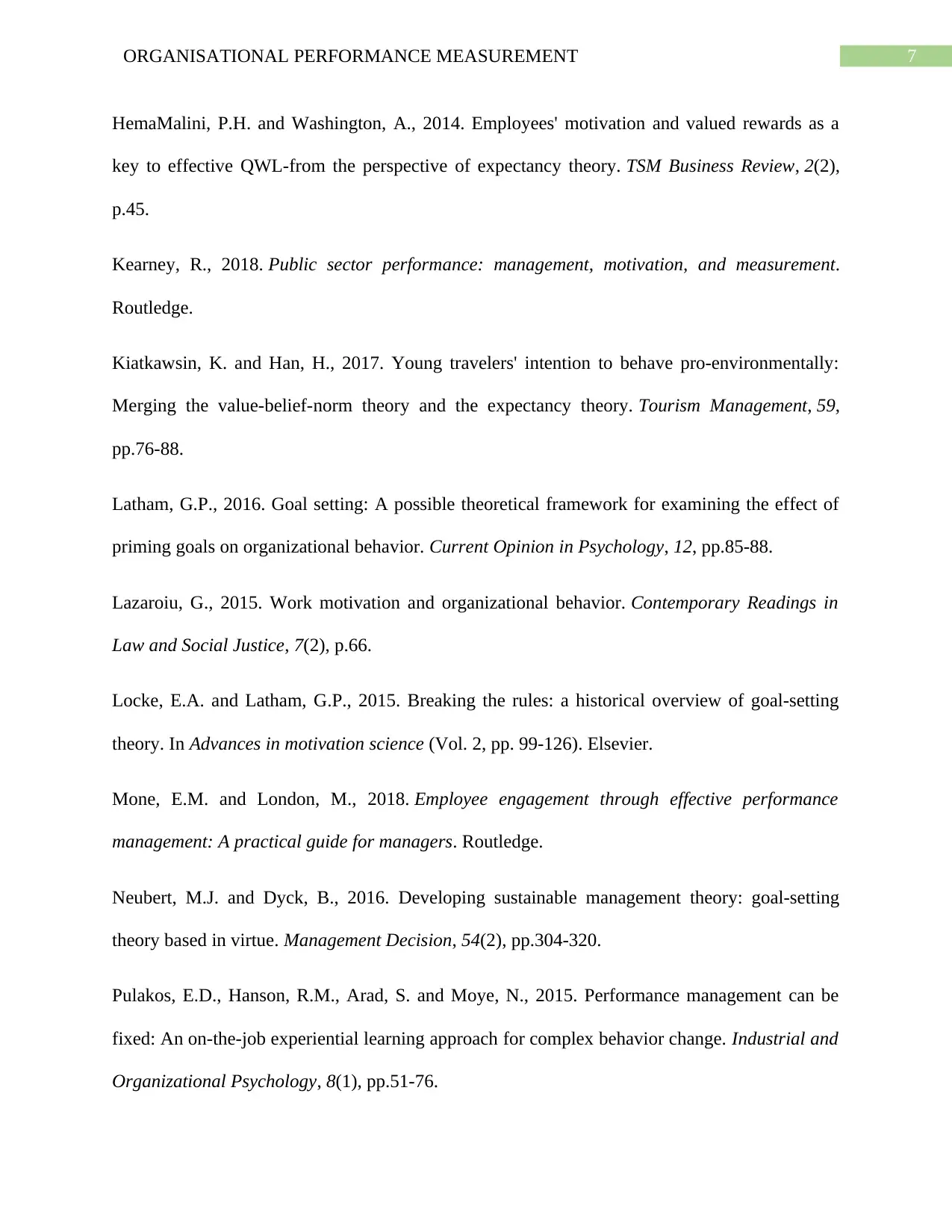
7ORGANISATIONAL PERFORMANCE MEASUREMENT
HemaMalini, P.H. and Washington, A., 2014. Employees' motivation and valued rewards as a
key to effective QWL-from the perspective of expectancy theory. TSM Business Review, 2(2),
p.45.
Kearney, R., 2018. Public sector performance: management, motivation, and measurement.
Routledge.
Kiatkawsin, K. and Han, H., 2017. Young travelers' intention to behave pro-environmentally:
Merging the value-belief-norm theory and the expectancy theory. Tourism Management, 59,
pp.76-88.
Latham, G.P., 2016. Goal setting: A possible theoretical framework for examining the effect of
priming goals on organizational behavior. Current Opinion in Psychology, 12, pp.85-88.
Lazaroiu, G., 2015. Work motivation and organizational behavior. Contemporary Readings in
Law and Social Justice, 7(2), p.66.
Locke, E.A. and Latham, G.P., 2015. Breaking the rules: a historical overview of goal-setting
theory. In Advances in motivation science (Vol. 2, pp. 99-126). Elsevier.
Mone, E.M. and London, M., 2018. Employee engagement through effective performance
management: A practical guide for managers. Routledge.
Neubert, M.J. and Dyck, B., 2016. Developing sustainable management theory: goal-setting
theory based in virtue. Management Decision, 54(2), pp.304-320.
Pulakos, E.D., Hanson, R.M., Arad, S. and Moye, N., 2015. Performance management can be
fixed: An on-the-job experiential learning approach for complex behavior change. Industrial and
Organizational Psychology, 8(1), pp.51-76.
HemaMalini, P.H. and Washington, A., 2014. Employees' motivation and valued rewards as a
key to effective QWL-from the perspective of expectancy theory. TSM Business Review, 2(2),
p.45.
Kearney, R., 2018. Public sector performance: management, motivation, and measurement.
Routledge.
Kiatkawsin, K. and Han, H., 2017. Young travelers' intention to behave pro-environmentally:
Merging the value-belief-norm theory and the expectancy theory. Tourism Management, 59,
pp.76-88.
Latham, G.P., 2016. Goal setting: A possible theoretical framework for examining the effect of
priming goals on organizational behavior. Current Opinion in Psychology, 12, pp.85-88.
Lazaroiu, G., 2015. Work motivation and organizational behavior. Contemporary Readings in
Law and Social Justice, 7(2), p.66.
Locke, E.A. and Latham, G.P., 2015. Breaking the rules: a historical overview of goal-setting
theory. In Advances in motivation science (Vol. 2, pp. 99-126). Elsevier.
Mone, E.M. and London, M., 2018. Employee engagement through effective performance
management: A practical guide for managers. Routledge.
Neubert, M.J. and Dyck, B., 2016. Developing sustainable management theory: goal-setting
theory based in virtue. Management Decision, 54(2), pp.304-320.
Pulakos, E.D., Hanson, R.M., Arad, S. and Moye, N., 2015. Performance management can be
fixed: An on-the-job experiential learning approach for complex behavior change. Industrial and
Organizational Psychology, 8(1), pp.51-76.
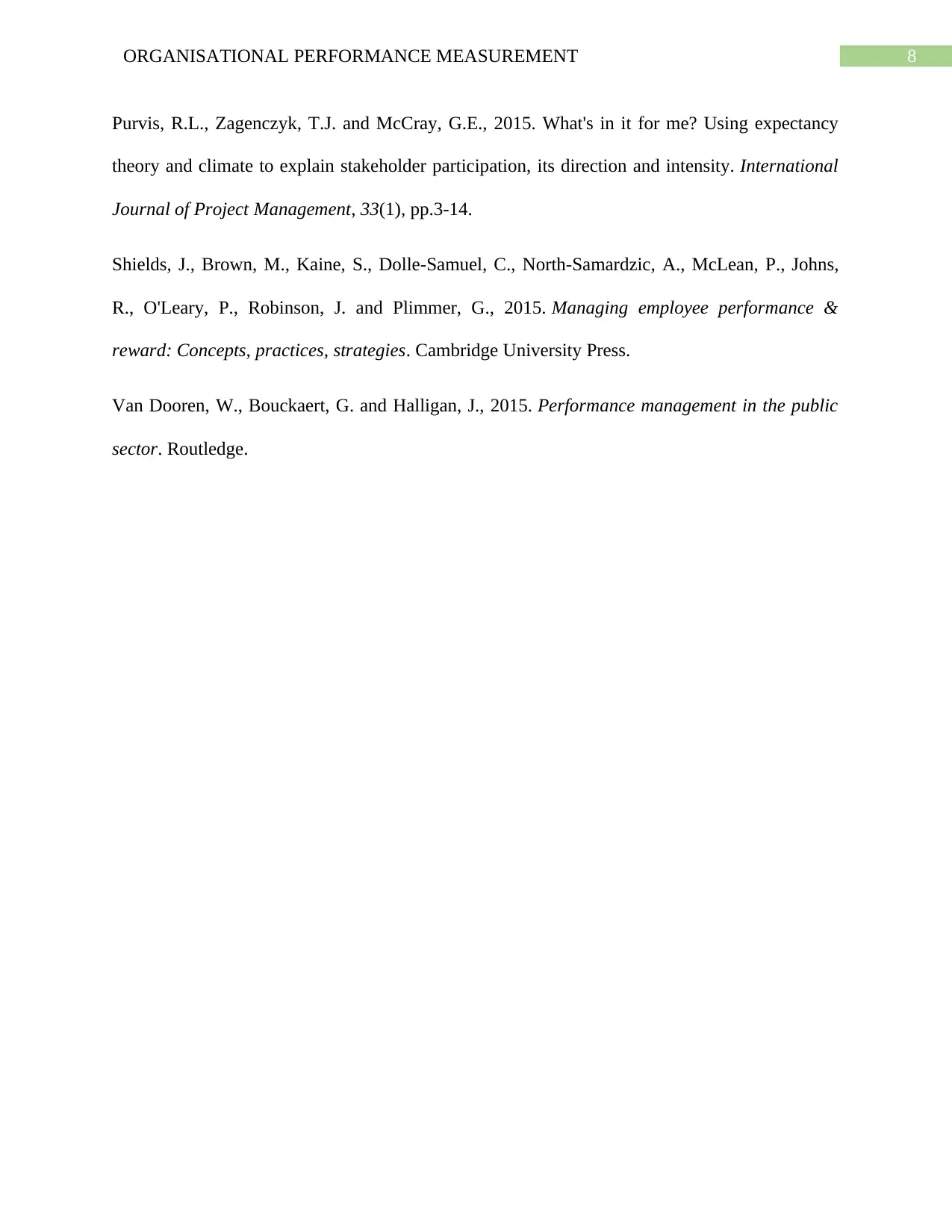
8ORGANISATIONAL PERFORMANCE MEASUREMENT
Purvis, R.L., Zagenczyk, T.J. and McCray, G.E., 2015. What's in it for me? Using expectancy
theory and climate to explain stakeholder participation, its direction and intensity. International
Journal of Project Management, 33(1), pp.3-14.
Shields, J., Brown, M., Kaine, S., Dolle-Samuel, C., North-Samardzic, A., McLean, P., Johns,
R., O'Leary, P., Robinson, J. and Plimmer, G., 2015. Managing employee performance &
reward: Concepts, practices, strategies. Cambridge University Press.
Van Dooren, W., Bouckaert, G. and Halligan, J., 2015. Performance management in the public
sector. Routledge.
Purvis, R.L., Zagenczyk, T.J. and McCray, G.E., 2015. What's in it for me? Using expectancy
theory and climate to explain stakeholder participation, its direction and intensity. International
Journal of Project Management, 33(1), pp.3-14.
Shields, J., Brown, M., Kaine, S., Dolle-Samuel, C., North-Samardzic, A., McLean, P., Johns,
R., O'Leary, P., Robinson, J. and Plimmer, G., 2015. Managing employee performance &
reward: Concepts, practices, strategies. Cambridge University Press.
Van Dooren, W., Bouckaert, G. and Halligan, J., 2015. Performance management in the public
sector. Routledge.
⊘ This is a preview!⊘
Do you want full access?
Subscribe today to unlock all pages.

Trusted by 1+ million students worldwide
1 out of 9
Related Documents
Your All-in-One AI-Powered Toolkit for Academic Success.
+13062052269
info@desklib.com
Available 24*7 on WhatsApp / Email
![[object Object]](/_next/static/media/star-bottom.7253800d.svg)
Unlock your academic potential
Copyright © 2020–2025 A2Z Services. All Rights Reserved. Developed and managed by ZUCOL.





